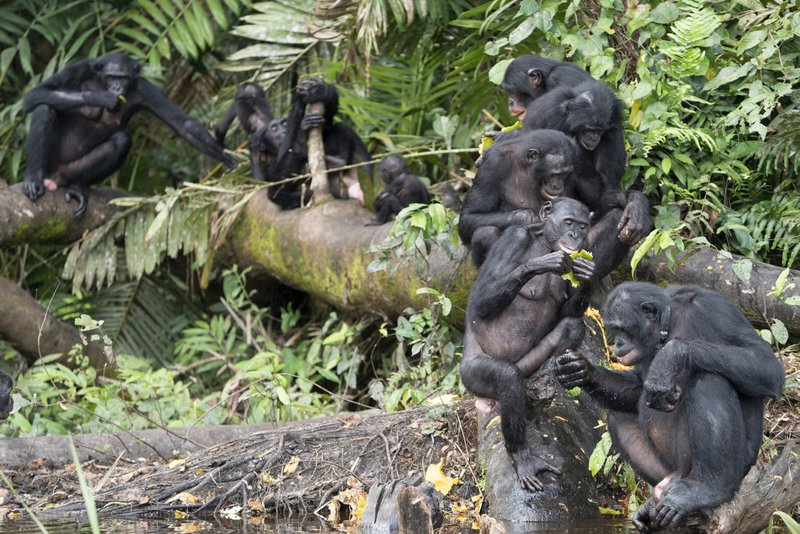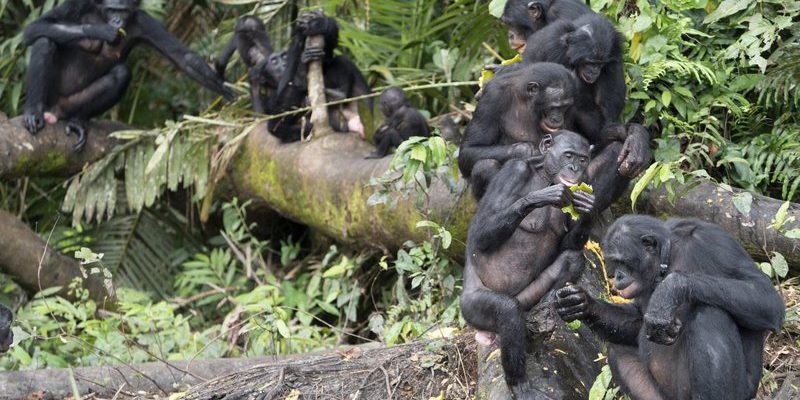
When you think of great apes, you might picture the mighty gorilla or the intelligent chimpanzee. But let me introduce you to the bonobo, a fascinating and often overlooked member of the ape family. These gentle creatures, native to the dense rainforests of the Congo Basin, are not just cute; they offer us a unique glimpse into the complex social structures and behaviors of our closest relatives. If you’ve ever been captivated by the idea of animal intelligence and cooperation, bonobos will leave you in awe.
With their playful nature, bonobos are sometimes referred to as the “hippies” of the ape world. They’re known for their peaceful interactions and strong social bonds, making them quite different from their more aggressive chimpanzee cousins. But there’s so much more to discover about these intriguing primates, from their diet and habitat to their role in biodiversity. Let’s dive deeper into the world of bonobos!
Physical Characteristics of Bonobos
Bonobos are often mistaken for chimpanzees, but they have distinct physical traits that set them apart. Adult bonobos typically weigh between 70 to 130 pounds and stand about 2 to 3 feet tall. They have larger bodies than chimps, with longer legs that give them a graceful appearance. Their faces are shaped differently, too; bonobos have a smaller skull and a more pronounced forehead, which makes their expressions incredibly endearing.
Their dark hair is another distinguishing feature, often appearing black or dark brown with a sleek texture. As bonobos age, they may develop a distinct gray or white streak in their fur. Moreover, their facial expressions are remarkably expressive, which plays a vital role in their social interactions. Just like us, bonobos use their faces to communicate emotions, and studies show that these expressions can convey joy, sadness, or even frustration.
Habitat and Range
Bonobos inhabit the lush rainforests of the Democratic Republic of the Congo (DRC). Their habitat is critical for their survival, as it provides both food resources and a safe environment from larger predators. Interestingly, bonobos are found only south of the Congo River, which acts as a natural barrier separating them from chimpanzees residing in the north. This geographic distinction has led to unique evolutionary adaptations in bonobos over time.
The dense forests where they thrive are teeming with life. Bonobos are often seen in the canopy, swinging gracefully from branch to branch in search of ripe fruits, leaves, and flowers. They are mostly arboreal, which means they spend a lot of time in the trees, though they do come down to the ground when necessary. Their habitat, rich with biodiversity, plays a crucial role in maintaining the health of the forest ecosystem.
Diet of Bonobos
Bonobos are omnivores, meaning they eat a variety of foods, but they primarily consume a largely vegetarian diet. In fact, approximately 60% of their diet consists of fruit, particularly figs, which they are quite fond of. They are also known to munch on leaves, flowers, and seeds when fruit is scarce. When exploring their environment, you’ll find bonobos engaging in foraging behavior, using their long fingers to pick fruit and nuts.
Occasionally, bonobos will eat small animals, such as insects, or even other small mammals, but this is quite rare and often opportunistic. Their foraging behavior is fascinating; they often work together to gather food, showcasing their collaborative skills. This social aspect of eating is essential, as it strengthens their bonds and helps them navigate the complex social structures within their groups.
Social Structure and Behavior
Here’s where things get really interesting. Bonobos are renowned for their unique social structures, which are matriarchal, meaning females usually lead the groups. This is quite a departure from many other primate societies, where males often take on dominant roles. In bonobo communities, females tend to form strong alliances and use these bonds to maintain peace and harmony. It’s a refreshing example of cooperation over competition.
Their interactions include playful behavior, grooming, and even sharing food, which reinforce their social connections. Bonobos often engage in various forms of play that can last for hours. They chase each other, swing from branches, and even indulge in flirtatious displays that resemble courtship. Interestingly, sexual behavior is common among bonobos and serves multiple purposes beyond reproduction; it’s a way to resolve conflicts and strengthen social ties.
Reproductive Behavior and Lifespan
Bonobo reproduction is quite intriguing. Females typically give birth to a single offspring every four to six years, which is relatively slow compared to other primates. The bond between a mother and her young is incredibly strong, with mothers nurturing their children for several years until they are ready to become independent. Young bonobos learn important social skills through play and mimicry, using their time with others to prepare for life in their community.
Bonobos can live up to 40 years in the wild, but they can have a longer lifespan in captivity due to the absence of predators and regular food supply. Just like humans, bonobos continue to form lasting relationships throughout their lives. Their social bonds are not only crucial for their emotional well-being but also for their survival in the wild, as cooperation is key to finding food and raising young.
Conservation Status and Threats
Sadly, bonobos are classified as endangered due to habitat destruction and hunting pressures. The forests they inhabit are increasingly threatened by logging, agriculture, and mining, which leads to a loss of their natural habitat. Additionally, the illegal bushmeat trade poses a significant threat to their population. Conservation efforts are underway, including habitat protection and education programs aimed at local communities to promote coexistence.
Organizations are working tirelessly to raise awareness about the importance of preserving bonobos and their habitats. By protecting these incredible creatures, we also safeguard the rich biodiversity of the rainforests. Supporting sustainable practices and ecotourism can make a real difference in ensuring the survival of bonobos for future generations. Protecting them is not just about saving a species; it’s about preserving a complex and fascinating ecosystem.
Table of Bonobo Facts
| Scientific Name: | Pan paniscus |
| Size: | 2-3 feet tall |
| Weight: | 70-130 pounds |
| Lifespan: | 40 years in the wild |
| Diet: | Fruits, leaves, seeds, and occasional small animals |
| Habitat: | Rainforests of the Democratic Republic of the Congo |
| Social Structure: | Matriarchal groups |
Frequently Asked Questions
What is the difference between bonobos and chimpanzees?
Bonobos and chimpanzees are both members of the great ape family, but they have distinct differences. While they share a common ancestor, bonobos are generally smaller with more slender bodies. Their facial structure also differs, with bonobos having a flatter face and a more pronounced forehead. Behaviorally, bonobos are known for their peaceful nature and matriarchal social structure, contrasting with the more aggressive dynamics often seen in chimpanzee groups.
How do bonobos communicate with each other?
Bonobos communicate through a range of vocalizations, facial expressions, and body language. They use soft grunts to convey information and can express emotions through their faces, similar to humans. Grooming is also a vital part of their social communication; it reinforces bonds and helps maintain harmony within the group. The combination of these methods creates a rich tapestry of social interactions among bonobos.
Are bonobos endangered?
Yes, bonobos are classified as endangered. Their populations are threatened primarily due to habitat loss from logging and agriculture, as well as poaching for bushmeat. Conservation efforts are critical to help protect their habitats and ensure the survival of this unique species. Supporting sustainable practices and awareness campaigns can help mitigate these threats.
What do bonobos eat?
Bonobos primarily eat a diet rich in fruits, particularly figs, which constitute a significant portion of their intake. They also consume leaves, seeds, and occasionally small animals or insects. Foraging for food is a social activity for bonobos, which helps strengthen their bonds as they work together to gather resources.
How long do baby bonobos stay with their mothers?
Baby bonobos usually stay with their mothers for several years, typically until they are about 4 to 6 years old. During this time, they learn vital social skills and how to navigate the complexities of bonobo society. The maternal bond is incredibly strong, and mothers play a crucial role in the development of their young.
Can bonobos be kept in captivity?
While bonobos can be housed in zoos and sanctuaries, they require a specialized environment that mimics their natural habitat as closely as possible. Providing them with social interactions, enrichment activities, and space to climb is vital for their well-being in captivity. Many conservation programs focus on rehabilitation and reintroduction efforts, highlighting the importance of preserving their natural habitats rather than keeping them in captivity long-term.
What role do bonobos play in their ecosystem?
Bonobos play a crucial role in their ecosystem, particularly as seed dispersers. As they eat fruits and move through the forest, they help maintain the biodiversity of their habitat by spreading seeds throughout the area. This contributes to forest regeneration and the overall health of the ecosystem, making bonobos essential for the ecological balance of their surroundings.
How do bonobos resolve conflicts within their groups?
Bonobos are known for their peaceful approaches to conflict resolution. Instead of using aggression, they often engage in sexual behaviors, grooming, and playful interactions to diffuse tension and restore harmony. Their social structure emphasizes cooperation and bonds among individuals, which helps them maintain a relatively calm and cohesive group.
Where can I see bonobos?
Bonobos can typically be seen in specialized zoos and wildlife sanctuaries that focus on conservation efforts. Some programs may even allow for ecological tours in the Democratic Republic of the Congo, where you can observe them in their natural habitat. It’s essential to choose responsible ecotourism options that prioritize conservation and animal welfare.
How intelligent are bonobos compared to other primates?
Bonobos are considered to be highly intelligent, showing advanced problem-solving skills, social awareness, and emotional understanding. They have been observed using tools, demonstrating an ability to learn and adapt to their environments. Their social intelligence is particularly noteworthy, as they can navigate complex relationships and work cooperatively with others, often relying on empathy and shared experiences to strengthen their community ties.

